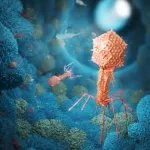(Press-News.org) ITHACA, N.Y. – Researchers from the Charles H. Dyson School of Applied Economics and Management have developed a new method for measuring food insecurity, which for millions of people in the U.S. is more than just an abstract concept.
The group’s probability of food security (PFS) measures the likelihood that a household’s food expenditures equal or exceed the minimum cost of a healthful diet. The researchers then put the PFS to the test, analyzing food security dynamics over a recent 17-year period, and found that a third of U.S. households experienced at least temporary food insecurity.
Seungmin Lee, a doctoral student in the field of applied economics and management, was lead author of “Food Security Dynamics in the United States, 2001-2017,” which published Oct. 26 in the American Journal of Agricultural Economics.
Co-authors were Chris Barrett, the Stephen B. and Janice G. Ashley Professor of Applied Economics and Management at Dyson, and John Hoddinott, the H.E. Babcock Professor of Food & Nutrition Economics and Policy in the Division of Nutritional Sciences, in the College of Human Ecology.
This research sprang from Barrett and Hoddinott’s previous work examining poverty and food insecurity dynamics in low-income countries. According to the U.S. Department of Agriculture (USDA), at least one in 10 U.S. households has been food insecure in any given year since 1995, when it began reporting its official food security measure, the Food Security Supplement to the Current Population Survey (CPS-FSS).
The CPS-FSS has its roots in the Radimer-Cornell Hunger Scale, developed by then-doctoral student Kathy Radimer, Ph.D. ’90.
“In the United States, there has been much less work on food insecurity dynamics than in many low-income countries, but it’s no less salient here,” said Barrett, who also has an appointment in the Brooks School of Public Policy. Hoddinott noted that while the U.S. is very wealthy on average, “there is a significant fraction of the population who are really poor and do not have the resources to acquire an adequate and healthy diet.”
While about a third of U.S. households experienced some food insecurity over the 17-year period the team studies, for about half of them, it was just temporary – what the researchers termed “transitory food insecurity.” For the rest, who experience “chronic food insecurity,” more long-term means of food assistance are necessary.
“This matters for policymakers,” Barrett said. “Knowing which sort of food insecurity different people experience is really crucial to designing effective policy to safeguard people’s basic human right to food.”
PFS measures the estimated probability that a household’s food expenditures will equal or exceed the minimal cost of a healthful diet as reflected by the USDA’s Thrifty Food Plan cost, which informs the basis for maximum benefits in the federal government's Supplemental Nutrition Assistance Program, known as SNAP.
The PFS is based on household food expenditure data, and constructed using the estimated association between food expenditures and household characteristics that are strongly associated with food security – including gender, race and educational attainment of the household head.
PFS is calibrated so that the food insecurity prevalence it estimates exactly equals prevalence estimates based on the USDA’s Food Security Scale Score. Thus while the PFS is not identical to food insecurity as currently measured in the U.S., it tracks the official measure in a way that uncovers food insecurity dynamics that cannot be studied using the official measure – in particular, the likely duration and severity of food insecurity.
“How many households are just briefly food insecure and need a food pantry to tide them over, versus one that needs SNAP benefits, or Social Security for those who have disabilities?” Lee said. “That’s where you need to study dynamics, you need to study what happens to people over time.”
For the 17-year period they studied, the researchers found, using PFS, that two-thirds of U.S. households experienced no food insecurity, and of those that became food insecure at any moment in time, on average, more than half regained food security within two years. They also found that households headed by female, non-white or less educated individuals disproportionately suffered persistent or severe food insecurity.
“PFS gives us this ability to distinguish between chronic and transitory food insecurity,” said Hoddinott, who also has appointments at Dyson and in the Department of Global Development. “That’s something that, to the best of our knowledge, no one has been able to do before in the United States. PFS identifies very particular groups with very particular food security needs, and thus allows for potentially a more refined approach to addressing food insecurity issues in the United States.”
This work was supported by grants from the USDA Economic Research Service and the USDA National Institute of Food and Agriculture.
For additional information, see this Cornell Chronicle story.
Cornell University has dedicated television and audio studios available for media interviews.
-30-
END
New tool measures food security duration, severity
2023-10-26
ELSE PRESS RELEASES FROM THIS DATE:
Excess fluoride linked to cognitive impairment in children
2023-10-26
Long-term consumption of water with fluoride levels far above established drinking water standards may be linked to cognitive impairments in children, according to a new pilot study from Tulane University.
The study, published in the journal Neurotoxicology and Teratology, was conducted in rural Ethiopia where farming communities use wells with varying levels of naturally occurring fluoride ranging from 0.4 to 15.5 mg/L. The World Health Organization recommends fluoride levels below 1.5 mg/L.
Researchers ...
Scientists find two ways that hurricanes rapidly intensify
2023-10-26
Contacts:
David Hosansky, UCAR/NCAR Manager of Media Relations
hosansky@ucar.edu
720-470-2073
Audrey Merket, UCAR/NCAR Science Writer and Public Information Officer
amerket@ucar.edu
303-497-8293
Hurricanes that rapidly intensify for mysterious reasons pose a particularly frightening threat to those in harm’s way. Forecasters have struggled for many years to understand why a seemingly commonplace tropical depression or tropical storm sometimes blows up into a major hurricane, packing catastrophic winds and driving a potentially deadly surge of water ...
Is red meat intake linked to inflammation?
2023-10-26
Inflammation is a risk factor for many chronic diseases, including cardiovascular disease (CVD), and the impact of diet on inflammation is an area of growing scientific interest. In particular, recommendations to limit red meat consumption are often based, in part, on old studies suggesting that red meat negatively affects inflammation – yet more recent studies have not supported this.
“The role of diet, including red meat, on inflammation and disease risk has not been adequately studied, which can lead to public health recommendations that are not based on strong evidence,” said Dr. Alexis Wood, associate professor of pediatrics – ...
RIT’s Campanelli receives award for work in gravitational wave science
2023-10-26
Rochester Institute of Technology distinguished professor and founding director of the Center for Computational Relativity and Gravitation Manuela Campanelli has been honored with the American Physical Society’s (APS) 2024 Richard A. Isaacson Award in Gravitational-Wave Science for her extraordinary contributions to and leadership in the understanding and simulation of merging binaries of compact objects in strong-field gravity.
The annual honor is granted to esteemed scientists for their remarkable achievements in the fields of gravitational-wave physics, gravitational wave astrophysics, and associated ...
Fruit, nectar, bugs and blood: How bat teeth and jaws evolved for a diverse dinnertime
2023-10-26
Link to full release with images:
https://www.washington.edu/news/2023/10/26/bat-teeth/
(Note: researcher contact information at the end)
They don’t know it, but Darwin’s finches changed the world. These closely related species — native to the Galapagos Islands — each sport a uniquely shaped beak that matches their preferred diet. Studying these birds helped Charles Darwin develop the theory of evolution by natural selection.
A group of bats has a similar — ...
Mobile stroke units increase odds of averting stroke
2023-10-26
Receiving a clot-busting drug in an ambulance-based mobile stroke unit (MSU) increases the likelihood of averting strokes and complete recovery compared with standard hospital emergency care, according to researchers at Weill Cornell Medicine, NewYork-Presbyterian, UTHealth Houston, Memorial Hermann-Texas Medical Center and five other medical centers across the United States.
The study, published online in the Annals of Neurology on Oct. 6, determined that MSU care was associated with both increased odds of averting stroke compared with hospital emergency medical service (EMS) – ...
Why are so many migrant families still separated? Chaos in the data
2023-10-26
U.S. government reached a settlement with thousands of families separated under the zero-tolerance policy
Experts highlight ‘mountain of a challenge’ that U.S. Family Reunification Task Force has had in accounting for separations
Task force reuniting families is working within a limited scope of separated families
‘If using DNA data to reunite families could help even one child, it’s worth giving it a shot,’ says researcher
CHICAGO --- Five years since the retraction of the Trump-era zero-tolerance policy on illegal border crossings, which resulted in the separation ...
Mammalian cells may consume bacteria-killing viruses to promote cellular health
2023-10-26
Bacteriophages, also called phages, are viruses that infect and kill bacteria, their natural hosts. But from a macromolecular viewpoint, phages can be viewed as nutritionally enriched packets of nucleotides wrapped in an amino acid shell. A study published October 26th in the open access journal PLOS Biology by Jeremy J. Barr at Monash University, Victoria, Australia, and colleagues suggests that mammalian cells internalize phages as a resource to promote cellular growth and survival.
Phage interactions with bacteria are well known, and interactions between bacteria and their mammalian host can lead ...
New research finds stress and strain changes metal electronic structure
2023-10-26
New research from the University of Birmingham shows that the electronic structure of metals can strongly affect their mechanical properties.
The research, published today (26th October) in the journal Science, demonstrates experimentally, for the first time, that the electronic and mechanical properties of a metal are connected. It was previously understood theoretically that there would be a connection, but it was thought that it would be too small to detect in an experiment.
Dr Clifford Hicks, Reader in Condensed Matter Physics, who worked on the study said: “Mechanical properties are typically described ...
A superatomic semiconductor sets a speed record
2023-10-26
Semiconductors—most notably, silicon—underpin the computers, cellphones, and other electronic devices that power our daily lives, including the device on which you are reading this article. As ubiquitous as semiconductors have become, they come with limitations. The atomic structure of any material vibrates, which creates quantum particles called phonons. Phonons in turn cause the particles—either electrons or electron-hole pairs called excitons—that carry energy and information around electronic devices to scatter in a matter of nanometers and femtoseconds. This means that energy is lost in the form of heat, and that information transfer has ...


